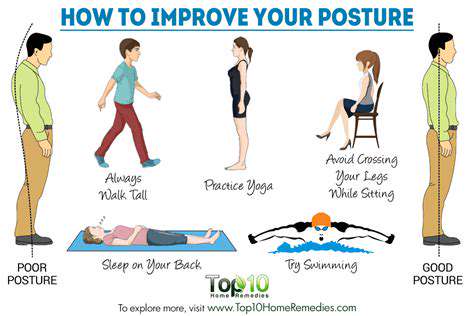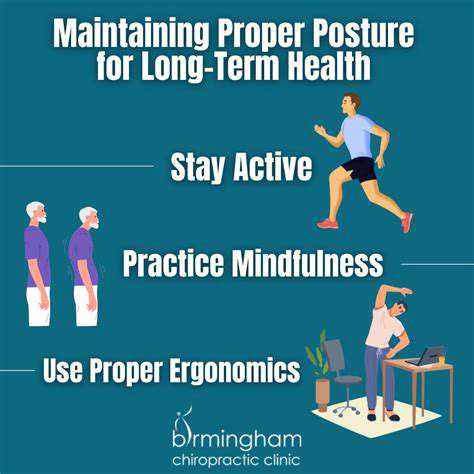How to Improve Your Sitting Posture
Identifying Your Current Posture
Understanding the Importance of Posture
Maintaining good posture is crucial for overall well-being. It's not just about looking good; proper posture supports your spine, reduces strain on your muscles, and improves your breathing. When your posture is aligned correctly, it allows your body to function efficiently, reducing the risk of pain and discomfort in the long run. Poor posture, on the other hand, can lead to a variety of issues, from chronic back pain to headaches, and even affect your mood and energy levels. Understanding the significance of posture is the first step toward achieving and maintaining a healthy alignment.
Recognizing the impact of your posture extends beyond physical comfort. Good posture can significantly enhance your confidence and self-esteem. When you stand and sit tall, you project an image of strength and self-assurance. This positive self-perception can translate into improved interactions with others and greater success in various areas of life. Conversely, poor posture can inadvertently contribute to feelings of insecurity and low self-worth. So, taking proactive steps to improve your posture is a worthwhile investment in your overall well-being and self-image.
Identifying Common Posture Issues
Recognizing the subtle ways you might be compromising your posture is essential. Common posture issues often manifest in everyday activities, such as sitting at a desk, driving, or even standing for extended periods. One frequent problem is slouching, which often involves rounding the shoulders and hunching the back. Another common issue is forward head posture, where the head juts forward, placing undue stress on the neck and upper back. Understanding these common postural problems can help you identify specific areas that need attention and implement targeted improvements.
Beyond these basic issues, other posture problems can arise from repetitive movements or prolonged positions. For instance, prolonged periods of sitting in a chair without proper support can lead to discomfort and pain in the hips, lower back, and neck. Identifying these specific issues is crucial for developing tailored solutions. Observing yourself in different activities and taking note of any recurring postural patterns can help you pinpoint areas needing improvement. This self-awareness is critical for effective posture correction.
Assessing Your Current Posture
Taking a moment to assess your current posture is the first step in the journey towards improvement. This involves both self-observation and, if possible, seeking input from a trusted professional. Pay attention to how you sit in various situations, whether it's at your desk, in a meeting, or even while relaxing at home. Notice if your shoulders are slumped, if your head is jutting forward, or if your back is rounded. These observations are key to understanding your posture habits.
Consider using mirrors or asking a friend or family member to observe you from different angles. This external perspective can reveal subtle postural issues that you might not be aware of. Professional guidance from a physical therapist or chiropractor can further enhance your understanding. They can provide personalized assessments and tailored recommendations for improving your posture, focusing on specific areas of concern. This comprehensive approach ensures a holistic and effective posture improvement strategy.
Practical Exercises for Posture Improvement

Standing Posture Exercises
Improving your standing posture involves engaging your core muscles and maintaining a balanced alignment. One crucial exercise is the wall-stretch, where you stand with your back flat against a wall, ensuring your head, shoulders, and glutes are all touching the wall. This promotes correct spinal alignment, helping you develop a more natural and healthy posture. Another effective exercise is the shoulder blade squeeze, which strengthens the muscles surrounding your scapulae. Perform this exercise by squeezing your shoulder blades together, holding for a few seconds, and then releasing. Repeat this several times throughout the day for visible improvements.
Sitting Posture Exercises
Maintaining good posture while seated is vital to prevent back pain and discomfort. A simple yet effective technique is to use a lumbar support cushion. This provides extra support for your lower back, encouraging proper spinal alignment. Another key element is maintaining a neutral spine. Avoid slouching or hunching over your desk. Sit with your feet flat on the floor, ensuring your knees are at a 90-degree angle. This posture helps distribute weight evenly and alleviates stress on your back.
Walking Posture Exercises
Walking posture exercises are excellent for improving your overall posture and balance. A common exercise is to consciously engage your core muscles while walking. This helps to maintain a stable posture and prevents your body from collapsing or shifting unnaturally. Another crucial aspect is to maintain a tall posture, keeping your head up, shoulders relaxed, and abdomen engaged. Try to visualize a string pulling you upwards from the crown of your head, which will help you maintain an upright and balanced posture while walking. This consistent effort over time will improve your posture and reduce the risk of future back problems.
Core Strengthening Exercises
Core strengthening exercises are fundamental for overall posture improvement. Planks are a highly effective exercise for strengthening core muscles, which are essential for maintaining a stable and upright posture. By engaging your core, you're essentially stabilizing your spine and improving your posture in all positions. Hold the plank position for as long as you can, gradually increasing the duration as you get stronger. Another beneficial exercise is the side plank, which targets the obliques and further strengthens the core muscles responsible for supporting your spine. Consistency with these exercises will help you to develop a strong core, which in turn will support better posture.
Posture Correction Techniques
Beyond specific exercises, daily posture correction techniques are essential for long-term improvements. Pay attention to your posture throughout the day, whether you're standing, sitting, or walking. Whenever you notice yourself slouching, consciously correct your posture to a more upright position. This mindful awareness can significantly improve your posture over time. Consider using posture-correcting devices, such as posture braces or straps. These aids serve as visual reminders, prompting you to maintain good posture. Regularly practicing these techniques can lead to lasting improvements in your posture over time.

Read more about How to Improve Your Sitting Posture
Hot Recommendations
- Grooming Tips for Your Bag and Wallet
- Best Base Coats for Nail Longevity
- How to Treat Perioral Dermatitis Naturally
- How to Use Hair Rollers for Volume
- How to Do a Graphic Eyeliner Look
- Best DIY Face Masks for Oily Skin
- Guide to Styling 4C Hair
- Guide to Improving Your Active Listening Skills
- How to Fix Cakey Foundation
- Best Eye Creams for Wrinkles

![How to Do a Red Lip Look [Classic & Bold]](/static/images/29/2025-05/MasteringtheClassicRedLip3AATimelessChoice.jpg)

![Best Jeans for Every Body Type [Find Your Fit]](/static/images/29/2025-05/AppleShapes3AFindingJeansThatBalanceYourSilhouette.jpg)
![How to Dress for a Rainy Day [Stay Stylish & Dry]](/static/images/29/2025-05/AccessorizingforAddedProtectionandStyle.jpg)





![Best Budget Winter Coats [2025]](/static/images/29/2025-07/DurableandStylishOptions2824250-2450029.jpg)